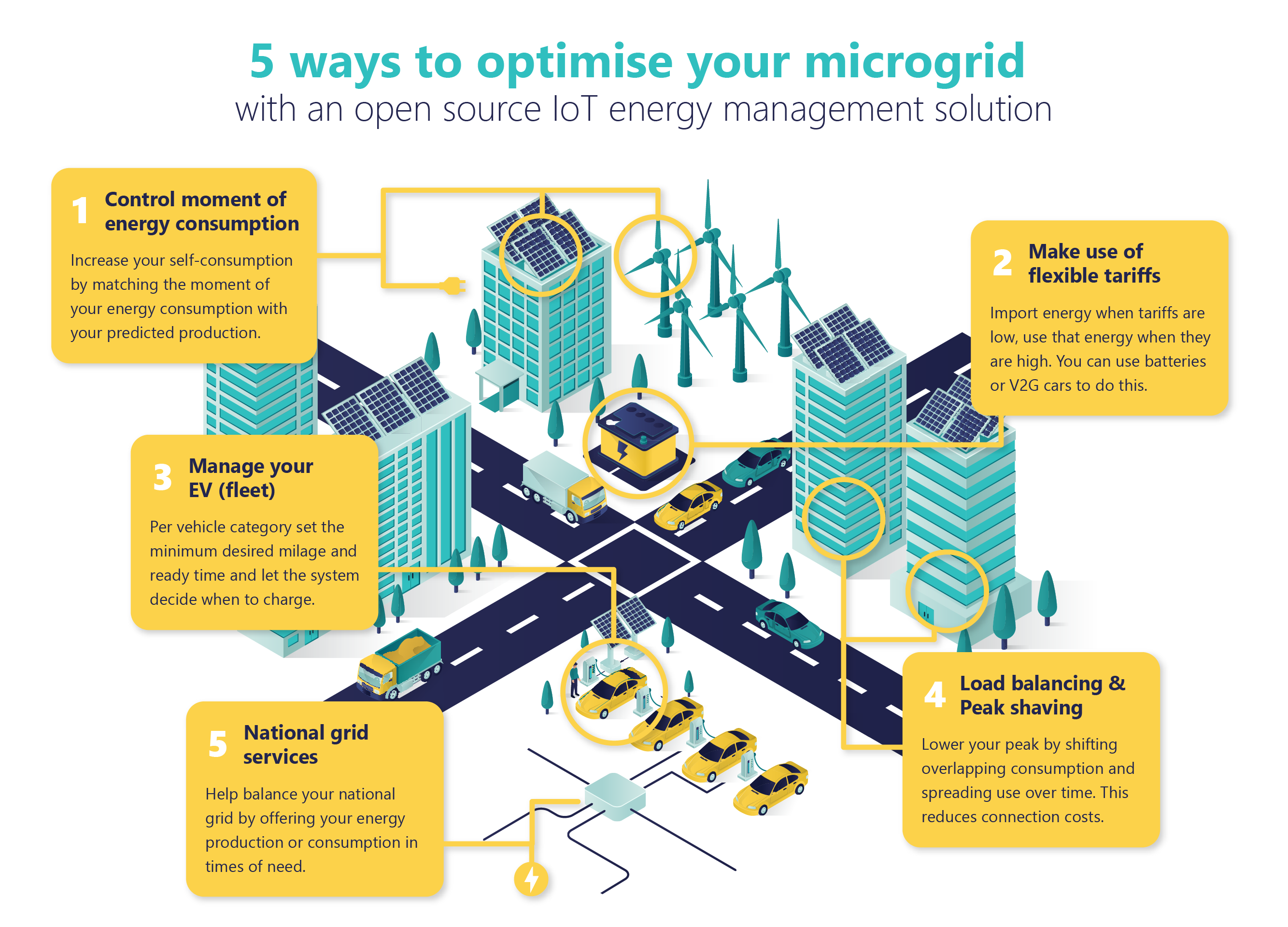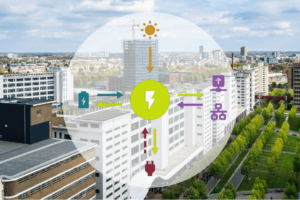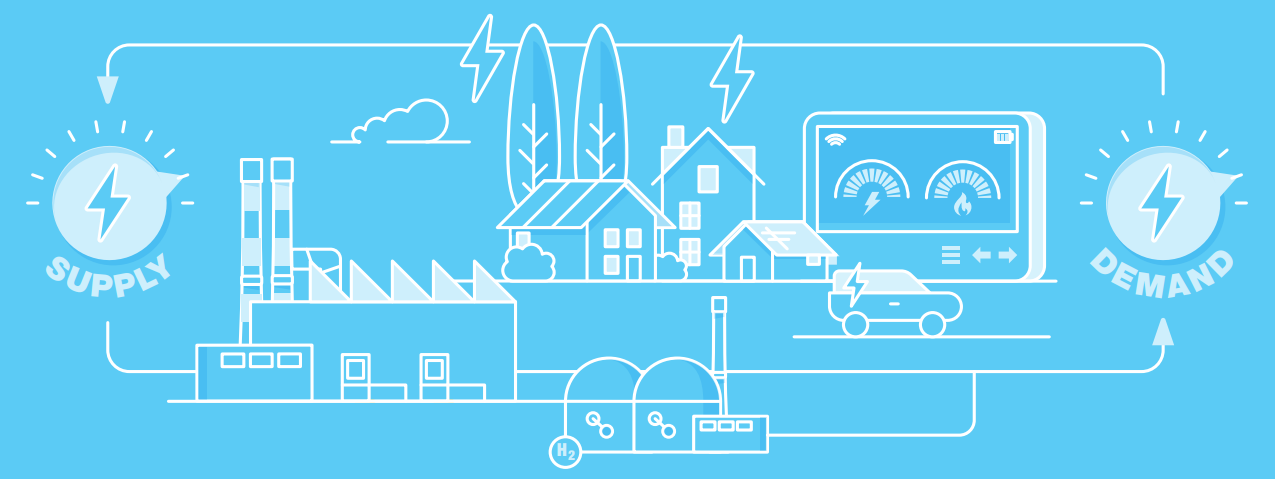
Microgrid optimization with IoT
Microgrids today are gaining in popularity thanks to renewable energy projects across the world. They bring many advantages but are not without challenges, particularly if they are to work effectively with traditional macrogrids. Smart Energy Management Systems (SEMS) are designed to help grid operators automatically manage energy production and consumption as efficiently as possible, to save costs, reduce CO2 emissions, and maintain stability of the electricity networks at all times.
The IoT field has evolved very quickly in the past few years, with the emergence of highly effective open source IoT platforms that are particularly well suited to the development of SEMS. The most important advantage of the open source IoT model is the vendor independent nature of this approach and the flexibility to adjust to a changing market. This provides grid operators with greater control over their assets, to keep up to date with the latest market requirements, and to develop or extend their energy management systems in line with their needs.
Advanced IoT technologies are now delivering new energy optimisation capabilities to microgrid managers for smart cities and buildings. Done well, SEMS can deliver up to 10-30% extra carbon and financial savings by efficiently using renewable energy production.
 IoT solutions allow for the quick connection of all the assets (or ‘Things’) that a microgrid comprises so that they can be monitored and controlled. The platform will collect the data generated by these assets and from external (open) sources, such as weather, building heating set points and car usage. Algorithms then come into play, providing essential decision making by using accurate predictions of production, consumption, and grid energy tariffs. This article outlines 5 key areas of energy optimisation opportunities.
IoT solutions allow for the quick connection of all the assets (or ‘Things’) that a microgrid comprises so that they can be monitored and controlled. The platform will collect the data generated by these assets and from external (open) sources, such as weather, building heating set points and car usage. Algorithms then come into play, providing essential decision making by using accurate predictions of production, consumption, and grid energy tariffs. This article outlines 5 key areas of energy optimisation opportunities.
1. To improve self-sufficiency by controlling and increasing self-consumption
For microgrid operators, the objective is to consume as much locally produced renewable energy as possible. This can be achieved by controlling “consumers” or assets. In this context, “consumers” are devices or a group of devices that can (indirectly) use the locally produced energy, such as electricity consumption in buildings, EV cars, and outdoor lighting. The ability to control the rate at which these consumers, consume locally produced renewable energy is important, as it opens up opportunities for energy optimisation.
With accurate weather predictions, the SEMS can determine how much energy will be produced by PV panels and wind turbines and can also predict consumption of assets based on historical data. With this information the system can take action to adapt consumption to meet the optimal energy requirements, such as timing the charge of electric vehicles for when locally produced energy is available (in time for the vehicles next ride of course!). Another example would involve using batteries to store any surplus energy generated by solar PV panels, to use it when the sun is down, and the lights are switched on.
2. To take advantage of flexible energy tariffs
An increasing number of energy suppliers are adopting hourly flexible tariffs that should be considered when making economical charge and discharge decisions or deciding the most appropriate time to sell surplus energy back to the grid. In this way, energy “consumers” can be used as energy “buffers”. For example, a building can be cooled down to the desired setpoint earlier in the day than required, to take advantage of a lower electricity price or 100% renewable supply. The energy is kept in the building as cool air, then the temperature rises, and energy prices go up, the building will not need as much energy to stay at the desired temperature. In some cases, batteries could be charged up at the lowest rate and the stored energy sold at the highest rate to generate earnings after deducting the levelized cost of storage of the battery.
Whatever the use case, the ability to navigate hourly flexible tariffs can lead to considerable cost-savings over time.
3. To optimize EV fleet management and V2G
IoT Solutions offer considerable advantages to optimise electric vehicle fleet management and V2G (vehicles-to-grid).
 To manage fleets with several groups of electric vehicles, smart energy management systems can establish schedules with times and minimum mileage needed for each group of vehicle. These schedules allow the system to choose the optimal time to charge the cars to their minimum mileage on the basis of desired parameters such as lowest cost or highest share of renewable energy. The system will also keep track of the performance and total energy use of each group, providing fleet managers with important insights in the day-to-day operations.
To manage fleets with several groups of electric vehicles, smart energy management systems can establish schedules with times and minimum mileage needed for each group of vehicle. These schedules allow the system to choose the optimal time to charge the cars to their minimum mileage on the basis of desired parameters such as lowest cost or highest share of renewable energy. The system will also keep track of the performance and total energy use of each group, providing fleet managers with important insights in the day-to-day operations.
Furthermore, the system can also charge beyond the minimum mileage at times of surplus green electricity or low electricity tariffs. For a fleet with vehicles that can also be discharged, any excess electricity can be sold back to the grid at a profitable moment (as described in example in 2 above).
4. To improve load balancing and peak shaving
Load balancing and peak shaving refer to levelling out and reducing peaks in electricity use by industrial and commercial power consumers. With control over multiple consumers and a prediction of upcoming energy production, microgrid operators can start to spread out their energy needs to reduce or reposition the peak. The optimization of peak shaving capabilities enables operators to maximize consumption of locally produced energy and reduce the generation and demand connection capacity required to operate, lowering their annual cost of electricity in the process.
5. Optimizing the balancing of the national grid
Macrogrid operators are tasked with maintaining a stable frequency of 50Hz. With an increasingly distributed and fluctuating renewable power generation; this balancing exercise becomes more difficult. Microgrid operators with large enough power production or consumption (together with partners), can support the macrogrid in this task by providing frequency response services to help restore grid balance in case of emergency.
These examples demonstrate that as microgrids evolve, the use of open source IoT technologies is ideal to develop smart energy management solutions, capable of generating important savings for microgrid operators and optimizing the interconnectivity with regional or national macrogrids.

Image by nationalgrideso.com
Start optimising your energy systems with OpenRemote
Our Open Source IoT-based energy management solution will help you address the challenges of integrating many different devices and data sources into a single, easy to use asset and data management solution. With the OpenRemote platform you will effectively transform data into information and create powerful customised applications. We can also help clients assess their challenges, and design, build, and manage their IoT applications. Our 100% open source solution can be applied to the management of any asset class, such as vehicle fleets, energy systems or crowd management; helping cities, buildings, airports, and many other sectors to become smarter.
Infographic image assets by Rizal Medanguide